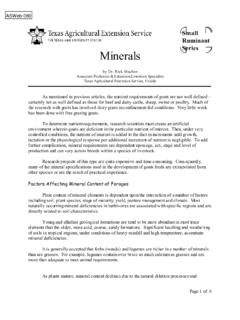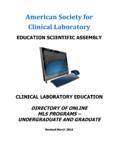Transcription of TEXAS A&M UNIVERSITY DEPARTMENT OF …
1 (Non-extended day length)ED (Extended day length) TEXAS A&M UNIVERSITYDEPARTMENT OF animal SCIENCEEQUINE sciences PROGRAMCONTROLLING HAIR LENGTH IN HORSESUSING EXTENDED DAY LENGTH REGIMESD. Douglas Householder, and Pete G. Gibbs, who show, fit and or sellhorses on a year round basis are concerned withcontrolling hair length. Old traditionalprocedures for maintaining short hair orshedding hair off horses have involved keepinghorses hooded and blanketed in heated barns. Heating barns is very expensive. Keepinghorses in warm barns, then taking them outsidein cold temperatures for exercise, may causehealth problems. To minimize these problems,horseman should consider utilizing extendedday length regimens to control hair length by Burkhardt (1947) firstdemonstrated that ovarian activity in mares wasinfluenced by photoperiod and with thehastening of estrus came the early shedding ofhair1. Photoperiod (day length) is a major factorgoverning hair growth in horses.
2 June 21(summer solstice) is the longest day (16 hoursday length) of the year; December 21 (wintersolstice) is the shortest day (10 hours daylength) of the year. The theory provide horses 16 hoursof day length during the fall and winter, tomimic the natural spring and summer hours ofday length. This procedure will retard fall hairgrowth and will cause shedding premature if ahorse has grown his winter hair and Householder (1980) studiedthe effects of extended vs. traditional day lengthregimens for controlling hair length in horses2,3. In this study 16 yearlings and 2-year-oldmares and geldings were randomly assigned tonatural day length or extended day lengthgroups. The project started October 1 when theextended day length (ED) group startedreceiving 16 hours of day light per day and thenon-extended day length (NED) groups receivednatural day light only. All horses were housedin the same non-heated barn and none of thehorses were blanketed throughout the project.
3 On day 1 the hair on a 1x2 inch square, underthe mane, was clipped then shaved to skin level. Hair from these areas was reclipped on days 28and 56 and measured for growth. Figure 1. shows the effect of extended photoperiod on 1. The Effect of Photoperiod on HairGrowth in HorsesOn day 28, regrowth of hair on thenon-extended day length (NED) horses andextended day length (ED) horses wasapproximately equal. As the natural day lengthbecame shorter through November and intoDecember, the hair on the NED horsescontinued to grow longer and the hair growth onthe ED horses was retarded. On December 6,the last day of the experiment hair length on theNED horses was almost three times longer thanthe ED LightIncandescent (clear or frosted) orfluorescent bulbs, and not colored heat lamps,should be used over or close to a horses stall. Research indicates that as little as 3 foot candlesof light at the horse's eye height will elicit Ten (10) foot candles is; however,the general routine recommendation.
4 Footcandles can easily be measured with anelectrician's photometer (light meter). Anothertechnique to measure light in stalls is to use thelight meter in single lens camera. To measurelight: 1) set the ASA to 400, 2) set the shutterspeed at seconds, 3) place a styrofoam cupover the lens and 4) read the aperture when thecamera is held at the level of a horse's eye heightin the stall5. Practically, if a newspaper can beeasily read, in any area of the stall, an excess of3 foot candles of light is present. A 200 wattincandescent bulb located approximately 10 footabove the floor, in a 12x12 stall, providesapproximately 10 foot candles of light in of TimersTwo types of timers are usuallyutilized. A box timer can be mounted betweenthe power source and the bulb(s). This timerwill turn all lights on/off mornings and on/offnights. Box timers cost approximately $ A receptacle timer plugs into a wall outlet. Atreble light then is plugged into the unit.
5 Thetimer turns individual lights on/off in themorning and on/off again at night. These typetimers costs approximately $ should receive 16 hours ofcontinuous light of at least 3 foot candles with 8hours of darkness each day. Light can be addedto either end of the day. Practically mosthorsemen add light both in the morning andevening as this compliments barn extended daylight (3 hrs.) + natural daylight (10 hrs.) + extended daylight (3 hrs.)16 hoursDec. 1 4:30 - 7:00 :30 - 8:30 horsemen set their timers and donot change them anytime during the year. Agradual buildup of light is not necessary. Twenty-four (24) hours of continuous light eachday will not elicit the response as a switch fromdark to light to dark is needed each day. Be sureto replace burnt out bulbs and reset timers afterpower outages to maintain consistency inartificial lighting schedules. A few days out ofthe above regimen (ie. off at a show) will notcause horses to start growing hair; however,horses removed for longer periods of time ( days) will get out of "synch" and willstart growing hair.
6 In an attempt to save energy,limited research has been conducted to see if asingle pulse of light might elicit the sameresponse as 3 hours of continuous light. Theexact time of the photo inducible phase has notyet been identified by research; therefore,utilizing a pulse lighting program is not yetpractical at this the fall when horses are put under anextended lighting regimen, hair growth will beretarded. If put under lights in winter, hair coatshould start to slip by about 45 days, withanother 60 or more days required for the horseto shed completely. (Note: Horse owners willcertainly need to brush horses daily, especiallyas hair first begins to turn loose. This will helploosen long hair.) In colder weather (underapproximately 55E F) a blanket or hood may benecessary to keep horses comfortable. Stallionsand geldings, as well as mares, respond toextended day length by shedding coat. Fieldobservations show that, occasionally, somehorses under extended light for 3-4 years, willbecome refractory to light and will "jump out" orstart growing hair.
7 Once these horses havegrown hair, an extended lighting regimen canagain be used and will control hair length forseveral years. Remember that mares underlights will cycle through the winter. Exposureof stallions to an artificial photoperiod in thefall, late winter and early spring will result in peaking of the breeding season earlier in theyear. If mares are to be bred between Februaryand June, a lighting program will not interferewith a stallion's reproductive performance. Ifmares are to be bred in late spring and latesummer, an artificial lighting program maybeunsatisfactory as it causes the stallion to peaktoo early in the use of an extended lightingprogram is an important management tool forhorsemen who need to get horses to slip winterhair or keep hair short throughout the year. Owners can combine artificial eitherincandescent or fluorescent and natural light togive horses 16 hours of light and 8 hours ofdarkness. With limited investment in a timerand proper installation, horse persons can keeptheir horses hair coat short with a minimalamount of Burkhardt, J.
8 , Transition from anestrus in themare and the effects of artificiallighting. J. Agr. Sci., Hodge, S., and Householder. 1980. Extended vs traditional day lengthregimens for controlling hair growth inhorses. Unpublished data. TexasA&M UNIVERSITY , College Station, Householder, (with Raena Wharton). 1980. Everyday is June 21. HorsemanMagazine, Houston, TEXAS . October, Loy, 1968. Effects of artificial lightingregimes on reproductive patterns inmares. Proc. - 14th Sharp, , Cleaver and Photoperiod. In-EquineReproduction. Lea and Febiger,Philadelphia and London. p. Palmer, E., Driancourt and 1982. Photoperiodicstimulation of the mare duringanoestrus. J. Reprod. and Fert. Pickett, 1993. Factors Affecting SpermProduction and Output, In-EquineReproduction. Lea and Febiger,Philadelphia and London. p.












